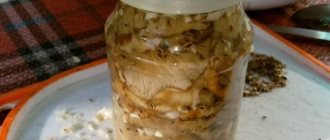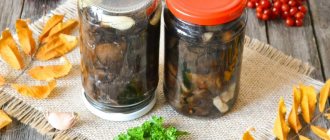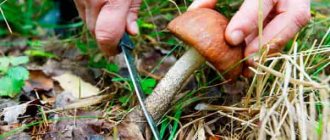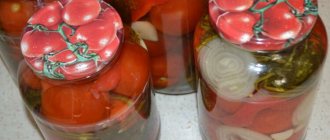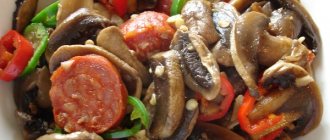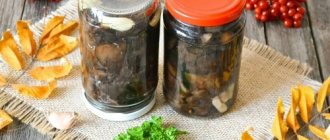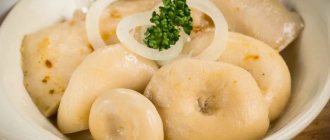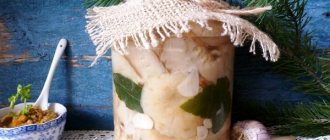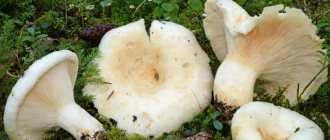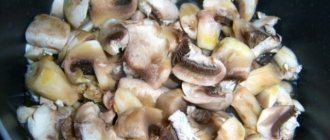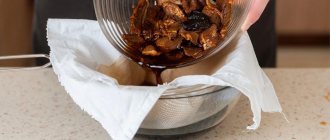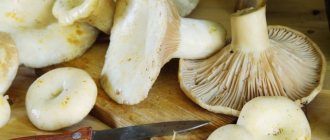Dear readers, during the forest harvest season I decided to return to mushrooms once again. Recently I shared recipes and told how to pickle mushrooms for the winter. See these recipes on the website. Today we will talk about another storage method - pickling mushrooms for the winter.
Pickling mushrooms can be varied. And not only salt and soda, but also various spices, herbs, sugar, onions and other ingredients can participate in the process of preparing forest delicacies for storage. They will certainly add their own flavor notes and give the dish a special zest.
Let's begin...
- How to properly sterilize jars for pickling and storage
- Salting mushrooms in a cold way - butter
- Dry salted saffron milk caps
- Salting boletus mushrooms for the winter, recipe for 1 liter of water
- Recipe for pickling assorted mushrooms
- Quick and easy cold salting of mushroom waxes (milk mushrooms)
- Hot-salted boletuses for the winter
How to properly sterilize jars for pickling and storage
I told you how to properly sterilize jars for sealing for the winter here; in this case, any of the described methods is suitable: under steam, in the oven, in the microwave. You can pickle mushrooms in a regular saucepan or in a barrel, washing them thoroughly. The main difference between jars and a pan (barrel) will be only that in the latter option you will have to eat the mushrooms within one or one and a half months, depending on the recipe. You can store the product in sealed jars until the new harvest season, that is, for a whole year.
Cold pickling of mushrooms - butter
Let me note that this method of pickling mushrooms is suitable for people who have a cold cellar or basement. You can make food in the refrigerator, but to do this you will need to clear some space in it for jars in advance. The cold pickling method involves cooking mushrooms at a temperature no higher than +16 degrees.
Ingredients:
- 5 kg. beautiful ones (choose small ones with even caps) are oiled.
- 10 leaves of currant bush.
- 10 grape leaves.
- A glass of salt (use coarse salt for salting).
- Dill inflorescences (umbrellas) – 10 pieces.
If the mushrooms are of different sizes, distribute them into groups: large, small and medium. First of all. Place the largest specimens on the bottom first, followed by the medium and small ones. Place butternut caps down.
Algorithm of actions:
Add a level spoonful of salt to the bottom of the container, place the first layer of mushrooms, the second and the third.
After the third layer, add salt again. We lay out four leaves of each plant and four dill umbrellas.
We apply the herbs with butter, now we make two layers and again add the herbs and salt.
We complete the laying out process and cover all this beauty with the remaining salt, grape and currant leaves, and dill.
Cover the container with gauze or any clean natural fabric.
We put a press on the fabric and put it in the cold for 25-30 days. If you find the butter to be salty, soak it a little (about an hour) in cold water before consuming. Such mushrooms should be stored in the cold for no more than two months, and remember, the longer they are stored, the saltier they become.
Salt the butter cold in a wooden tub, glass or enamel bowl. In other words, one that cannot be oxidized.
What you need to know when going into the forest
To prevent a trip to the forest from being in vain, you need to know the simple rules for collecting mushrooms:
- Collect only known specimens.
- Place young and worm-free ones in the basket.
- In order for the mycelium to produce a new harvest, tubular mushrooms are twisted out, and lamellar mushrooms are cut off with a sharp knife.
- They do not grow in windbreaks or tall grass.
- Place only in baskets, as they quickly deteriorate in bags, plastic or metal buckets.
Every mushroom picker knows that mushrooms are collected from spring to autumn. But autumn ones are more popular, since they can be prepared for future use: pickled, dried and salted. Pickling is an ideal way to preserve forest fruits for a long time.
Dry salted saffron milk caps
You can salt mushrooms in this way directly in jars, or first in a barrel or pan, then transfer them to jars for convenient storage. I recommend pickling saffron milk caps by laying them out with their caps facing up, sprinkling salt on each layer.
You will need to prepare:
- A kilogram of saffron milk caps.
- 50 grams of salt (about 2 tablespoons).
- 15 peas of black allspice.
- Horseradish leaf.
- 4 buds of cloves.
- If desired, a bunch of fresh dill and a few (three to four) cloves of garlic.
Cooking process step by step:
1. Sort through the forest gifts (remove stuck leaves and needles, scrape dirt from the legs). Now there is no need to wash the forest products; this method differs from others in that it is dry and in this case the products should not be wetted.
2. Place 1/2 part of a horseradish leaf, torn into pieces, but not very finely, at the bottom of the prepared containers; this product will not allow mold to appear during the salting process.
3. Chop the dill and peeled garlic, you need to crush it very finely, preferably larger ones. Mix these ingredients and divide into three parts. Place the first part on a horseradish leaf at the bottom of the jar, use the second in the middle and sprinkle the third on top of the ingredients.
Instead of dill, it is possible to use currant or oak leaves; this is the case if you salt in jars; if a wooden tub is used for salting, then it itself will give the product a pleasant woody aroma.
4. Place the first layer of saffron milk caps up, add salt, place the second and third layers, sprinkle with salt again, etc. until the container is completely filled. Salt should be used every two layers of mushrooms. Don’t forget to apply the prepared dill-garlic mixture about halfway through the salting process. Along with it, place cloves and peppercorns in jars (the latter products can be placed all at once, or distributed in parts bottom-middle-top).
Don’t worry that some of the layers will not be salted well; during the preparation process, the saffron milk caps will release juice and it will permeate all the products evenly.
If there are a lot of mushrooms, then calculate the amount of salt as follows. For each bucket of saffron milk caps, take 1.5 cups of coarse salt.
5. Cover the top of the saffron milk caps with the remaining horseradish and spices.
6. Cut a piece of gauze so that it is enough to cover the container. Place pressure on top of it, for example, a stone or a jar of water; if you salt mushrooms in a saucepan, leave the saffron milk caps in this form for 14 days in a cool place. Change the gauze every three days.
7. After 14-18 days, the saffron milk caps are ready. You can already serve them on the table and eat them with pleasure, with a pleasant feeling that you did it yourself and treat your friends. Or cover with tight lids and store in the refrigerator/cellar until convenient.
On a note! Salted mushrooms should be stored together with the brine, without draining it. If during the pickling process (during the first 7 days) space begins to appear in the container (the mushrooms secrete juice and settle), feel free to add a new portion there.
Be careful! During the cooking process, the saffron milk caps will change color and become darker, brownish-green, don’t worry, this is a common occurrence, it does not mean that you used a bad product.
Pickling rules
All edible mushrooms are suitable for pickling, both tubular and lamellar. The main thing is that these are strong young specimens without signs of a wormhole. Before salting, they are washed, and those that contain bitterness are soaked (volnushki, milk mushrooms, bitter mushrooms and valui).
There are several methods of pickling at home:
- cold method with pre-soaking;
- cold method without soaking;
- hot method.
Cold method with soaking
The usual method, which is suitable for all mushrooms that contain bitterness. They are washed and cleaned of contamination. Then fill with salted water (add ½ teaspoon of salt per liter of water). To quickly get rid of bitterness, the water must be changed several times a day.
Soaking time:
- milk mushrooms – 5 days;
- valui – week;
- waves - 2 days.
After soaking, the fruits are cleaned again and placed caps down in a clean container. Each layer is salted. Horseradish leaves, bay leaves, dill, currant, cherry and oak leaves, as well as pepper and cloves to taste are placed on the bottom of the container and on top.
The prepared mushrooms are covered with clean gauze, a disk and a press is installed. After a short time, a brine appears in which the mushrooms will be salted.
You don’t have to add spices and herbs to the milk mushrooms.
Cold method without soaking
The mushrooms are cleaned of soil and dirt, washed thoroughly and placed with their caps down in layers. Each layer is salted. To add flavor, you can add horseradish leaf, dill, allspice and black pepper, oak and currant leaves.
Readiness dates for some mushrooms:
- saffron milk caps - a week;
- milk mushrooms - month;
- valui – 2 months;
- waves - 40 days.
The best container for pickling is an oak barrel. After complete filling, the mushrooms are covered with clean gauze, a wooden disk and a press are installed. If the brine has not formed, it is necessary to select a larger size bend.
Hot salting
Accelerated method. Most specimens can be tasted within a few weeks. Mushrooms with bitterness are pre-boiled in salted water for about half an hour. Milk mushrooms - for 5 minutes.
Russulas, champignons and mushrooms do not need cooking; they are doused with boiling water and kept in it for about half an hour. After the preparatory stage, the mushrooms are pickled, as with the cold method.
The hot method is very popular because it does not require much time and effort.
Salting boletus mushrooms for the winter, recipe for 1 liter of water
Compound:
- Boletus mushrooms (in quantities per prepared liter container, the jar should be filled to the very neck);
- A liter of clean water.
- Cooking sil – 50 gr.
- Peppercorns – 5 pcs.
- A clove or two of garlic to your own taste.
- Bay leaf – 3 pcs.
- Fresh dill – 4 sprigs.
Hot cooking method:
Sort through and wash very thoroughly (you should wash until the water is completely clear). Dry the selected boletus mushrooms a little.
On a note! Salted boletus mushrooms turn out to be the most delicious if you use only the caps during the cooking process, but here you can see for yourself, if there is not much food, chop the legs as well.
Transfer the prepared boletus mushrooms to a saucepan.
Prepare brine from the ingredients indicated in the recipe. To do this, simply dissolve salt in hot water, add laurel, dill, pepper, garlic, boil for 2 minutes and pour all this over the mushrooms.
Place the mushrooms on the stove together with the brine, bring to a boil, and simmer for 20-25 minutes over low heat. At this point, do not forget to remove the resulting foam.
Place your favorite spices in ready-made sterilized jars (take what you like, dry herbs, fresh dill umbrellas, horseradish, parsley, garlic, mustard seeds, etc.). You can not use spices, but use those from which the brine was cooked.
Distribute the mushrooms into containers along with the brine, seal or roll up the products tightly, and let them cool. Be sure to store it in the refrigerator or any cool place.
Volnushki
Volnushka belongs to the Syroezhkov family. In young specimens the cap is convex, but with age it becomes flat with a deep depression in the center. The leg is strong and hard, pale pink in color.
When the plate is broken, abundant snow-white milky juice is released. The flesh of the mushroom is light, the taste is sharp and bitter.
Cold salting of volushki
For salting you will need:
- wavelets - 7 kilograms;
- salt – 200 grams;
- lemon juice – 1 tsp. ;
- dill and caraway seeds;
- cabbage leaf – 1-3 (across the width of the barrel).
Cooking method:
Soak clean mushrooms in salted, acidified water for 3 days, refreshing it periodically.
We lay the waves in layers with the plates facing up. Mix salt with cumin and dill. Salt each layer with this mixture. We cover the top one with cabbage leaves, install a wooden disk and place a weight.
We put the container in a cool room for several months. Before serving, the volushki must be soaked.
The same method can be used to pickle russula and champignons.
Recipe for pickling assorted mushrooms
To prepare for cooking:
- A kilogram of boletus, boletus and birch boletus.
- A glass of coarse salt about a third from the top.
- A bunch of dill and parsley.
- A large head of garlic.
Step by step steps:
Sort out all the gifts of the forest, rinse, place on paper towels, and let dry.
Wash and dry the prepared greens, chop not very finely with a knife.
Peel the garlic cloves and cut each into circles.
Add a little salt to a thoroughly washed pan, then a layer of mushrooms (place caps up), herbs, garlic, mushrooms again, a few pinches of salt (distribute evenly), repeat the layers in this order until everything is finished.
Cover the food with a cloth and place a bowl with a heavy load on it. Place in the refrigerator or cellar for 15-17 days.
After two weeks or more, take out the assortment and eat it or put it in jars. Seal it and you can store it in the cold. The shelf life at temperatures from +5 to +8 degrees is up to 5 months. If the storage temperature is higher, the shelf life is reduced.
Oyster mushrooms
Oyster mushrooms are lamellar mushrooms from the Oyster family. The cap is shiny, sometimes with a coating of mycelium. The color can be either gray or ash-violet. The leg is dense and short.
Mushrooms have an unusual taste and a faint aroma.
Salted oyster mushrooms hot and cold
Ingredients:
- oyster mushrooms – half a kilo;
- water – 2 liters;
- salt – 3 tbsp. l.;
- pepper and bay leaf - to taste;
- garlic – 3 cloves;
- granulated sugar – 1 tbsp. l.
Cooking method:
Hot method. We separate the hats from the legs. We divide large ones into parts and wash them.
Boil water, add all the ingredients, add the mushrooms and boil for 10 minutes, remembering to remove the foam.
Transfer the cooled fruits into the prepared jars, add the garlic and close the lids tightly. A day later we make the first test. Store the finished product in the refrigerator.
Cold way. For 2 kg of mushrooms we take 200 grams of salt.
Place spices, salt and mushrooms in layers at the bottom of the container. We salt each layer. Cover the top one with a clean towel and apply pressure. You can taste the dish in a week.
Hot-salted boletuses for the winter
Here you can save a little time on pre-processing. But, as you understand, the hot method of pickling mushrooms involves heat treatment. Or easier, cook it in boiling water.
For salting you will need to take:
- Two kilograms of boletus.
- Four tablespoons of salt (use chalk, but not iodized).
- 2-3 bay leaves.
- Eight black peppercorns.
- 6-7 dry clove buds.
- Two dill umbrellas.
- A bunch of fresh dill.
- Six currant leaves.
What does a Siberian guest look like?
Podtopolniki are mushrooms that are quite common in Siberia. They are also called poplar row, and they are popularly known as frosts. These mushrooms belong to the redovaceae family and are considered conditionally edible.
The poplar row has a hemispherical, convex and very fleshy cap, the diameter of which ranges from six to twelve centimeters. If you come across a representative whose cap has thin, cracked and curled edges or is wavy and flat, then you have fresh subtopolnik mushrooms (photo above). Its flesh has a dull, slightly reddish color.
The plates located on its cap grow together with the stem. An adult mushroom is easy to recognize - its plates are brown-red, while in a young individual they are completely white.
The legs of the subtopolniks are fleshy. Their length ranges from three to eight centimeters, and their width can reach four centimeters. Young and adult mushrooms have a stem of the same color as the plates. When you press it, a small dark spot may appear.
From August to October, Siberians collect floodplains. Mushrooms grow under poplar trees in large groups and are sometimes found in parks and on roadsides. Local people often store them for the winter.
Sorting
After the collection in the forest is completed, the fruits need to be sorted, preferably by variety, since the taste of the winter harvest will depend on this. Of course, many mushroom pickers dump all their finds into one vat and cook them together, but it’s better not to be lazy and sort them. Different types require different approaches to preparation, so it is necessary to prepare them separately.
Slicing
In order to figure out how to pickle mushrooms at home, you first need to know how to cut them correctly. To do this, they will need to be sorted. Leave the small ones as they are, and distribute the others into pieces of the same size, but not less than 6 cm.
Some mushrooms contain a large amount of easily oxidizing substances (mushrooms, champignons, boletus, boletus), so they quickly darken in air. In order to preserve their beauty and presentation, it is necessary to prepare a solution: pour 10 grams of salt and two grams of citric acid into 1 liter of water, and then send the prepared pieces there.
Cleaning
After sorting has been done, the product must be washed to remove dirt, debris, stuck needles and leaves, as well as the outer crust. The easiest way to prepare saffron milk caps and russula is to simply wipe them with a damp cloth or brush them. Much less often, the product is washed with running water, but after these activities it is thoroughly dried.
The remaining varieties are simply rinsed in a colander or in a bowl of water, but not for long, as this will affect the taste. It is necessary to cut off the dirty stems of mushrooms; in some varieties it is necessary to remove half the length.
Storage
For those who have figured out how to pickle mushrooms for the winter in jars, it will also be interesting how you can preserve the prepared product so that it remains tasty for a long time and does not spoil. To do this, it is recommended to use a well-ventilated and cool room with a temperature of approximately 5–6 degrees. They must not be allowed to freeze, as this will affect their taste. If the temperature is higher, there is a chance that they will turn sour and spoil. Periodically you need to check that the mushrooms are immersed in the brine, as without this they will turn black and moldy. If the liquid becomes low, you can add cool boiled water.
